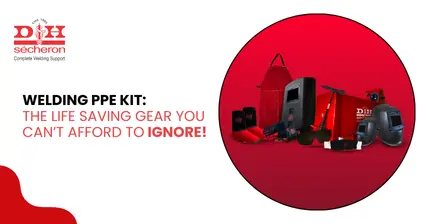What is Flux Core Welding Wire Used For?
Introduction
Flux-core welding wire, also known as flux-cored wire, is a versatile and widely used material in the welding industry. Whether you’re a seasoned welder or just starting out, understanding the applications, benefits, and considerations of flux core wire is essential. In this blog post, we’ll delve into the details of flux core welding wire and explore its various uses.
What Is Flux Core Wire Exactly?
Flux core wire is a type of welding wire that contains a core of flux. This wire is commonly used in automatic or semi-automatic welding machines. Let’s break down its components:
Outer Metal Layer: The outer layer of flux core wire consists of the actual weld metal. When melted during welding, this metal fuses the workpieces together.
Flux Core: Inside the wire tube, you’ll find compounds collectively known as flux. When these compounds melt in the welding arc, they create a shielding gas around the hot metal. This gas protects the weld from exposure to air, preventing impurities from contaminating the weld pool.
Why Is External Shielding Necessary?
Without the external shielding provided by flux core wire, the molten weld pool would readily pick up impurities from the surrounding air. This could lead to poor weld quality, including issues like porosity or even weld failure.
The Role of Slag
During flux core welding, you’ll notice a hard coating on top of the weld once it cools. This coating is called slag. Beneath the slag lies the smooth, well-formed weld. Slag plays a crucial role:
Shielding: Slag shields the weld during the welding process, preventing oxidation and contamination.
Direction of Travel: Properly formed slag glides off the weld surface, leaving behind a clean weld joint.
Types of Flux Core Wire
There are two main types of flux core wire:
1. Self-Shielded Flux Cored Wire (FCAW-S)
No External Gas: Self-shielded wire doesn’t require an external shielding gas. The flux core itself provides the necessary protection.
Applications: It’s commonly used outdoors or in windy conditions where using shielding gas is impractical.
Advantages: Portability, versatility, and ease of use.
Considerations: Requires direct current (DC) power.
Gas-Shielded Flux Cored Wire (FCAW-G)
External Shielding Gas: Gas-shielded wire relies on an external shielding gas (usually a mix of CO2 and argon).
Applications: Ideal for indoor welding and heavy-duty applications.
Advantages: High-quality welds, better control, and reduced spatter.
Considerations: Requires a welding gas supply.
When to Use Flux Core Wire
Construction: Flux core wire is excellent for structural welding, including bridges, buildings, and pipelines.
Fabrication: It’s commonly used in fabrication shops for joining thick materials.
Repairs: Flux core welding is effective for repairing heavy machinery, equipment, and vehicles.
Conclusion
At DNH Sécheron, we recognize the importance of reliable welding materials. Our commitment to quality aligns perfectly with the versatility and effectiveness of flux core wire. Whether you’re a professional welder or a DIY enthusiast, consider using DNH Scheron flux core wire for your welding projects.
Ready to elevate your welding game? Check out our website today to explore our range of high-quality flux core wire and take your welding projects to the next level!
11 May 2025 | Welding
An In-Depth Exploration of Low-Alloy Steel: Your Comprehensive Guide
11 May 2025 | Welding
Nagpur - Bori - Tuljapur Road MSH-3 in Yavatmal District (Maharashtra)
11 May 2025 | Welding
Guidelines to Understand Gas Welding: Applications, Advantages & Disadvantages
11 May 2025 | Welding
3 Tips for Finding the Best Mild Steel Electrode for Your Application
11 May 2025 | Welding
How to Select the Right Welding Filler Wires for Stainless Steel Welding?
11 May 2025 | Welding
Building the Narendra Modi Stadium with Norma V and Autotherme-1 Electrodes
11 May 2025 | Welding
Low Alloy Steel Welding in a (PEB) Pre Engineered Building Structure
11 May 2025 | Welding
Welding Rods: Different Types and Tips for Properly Storing and Handling
11 May 2025 | Welding
Tips for Flawless Welds with Stainless Steel Electrodes: Pros and Cons
11 May 2025 | Welding
Exploring Applications and Benefits of Stainless Steel Welding Electrodes
11 May 2025 | Welding
Welding Basics: Joining Metals with Heat and Pressure - A Beginners Guide
11 May 2025 | Welding
Distinguishing Low-Alloy Steel from High-Alloy Steel: Understanding the Variations
11 May 2025 | Welding
Hard Facing Wire - Understanding the Process and Achieving Optimal Result
11 May 2025 | Welding
Exploring the Advantages of Stainless Steel Electrodes in Welding Applications
11 May 2025 | Welding
Weathering Steel vs. Traditional Steel: A Comparative Analysis of Performance
11 May 2025 | Welding
Choosing the Right Welding Rod: Why 6013 Electrodes Might Be Your Ideal Option
11 May 2025 | Welding
Why 7018 Electrodes Are Preferred for High-Strength Welds in Pipeline Construction
11 May 2025 | Welding
Filler Wire vs. Stainless Steel Filler Wire: Understanding the Key Differences
11 May 2025 | Welding
Exploring the Impact of Filler Material on Welding Quality and Durability
11 May 2025 | Welding
Choosing the Right Cast Iron Electrode for Different Welding Projects
11 May 2025 | Welding
Top Advantages of Cast Iron Electrodes for Industrial Welding Applications
11 May 2025 | Welding
Key Benefits and Challenges of Using TIG Welding in Industrial Projects
11 May 2025 | Welding
5 Reasons Why 7018 Electrode is the Gold Standard for Welding Professionals
11 May 2025 | Welding
Top 5 Advantages of Flux Cored Arc Welding for Heavy-Duty Applications.png)
11 May 2025 | Welding
Lotherme-601: A Game-Changer for Restoring Shoulder Pins in Heavy Machinery
11 May 2025 | Welding
How D&H Sécheron Helped Repair a Rotary Kiln’s Cooler Section with LoTherme 352
11 May 2025 | Welding
Piston Repair for Mining Industry: Cost-Effective Solutions with LoTherme 468.webp)






.jpg)








































.jpg)
.jpg)

.jpg)

.jpg)





.jpg)
.jpg)
.jpg)



.webp)
.jpg)
.jpg)
.webp)
.jpg)





















.png)



.webp)

.webp)
.webp)



